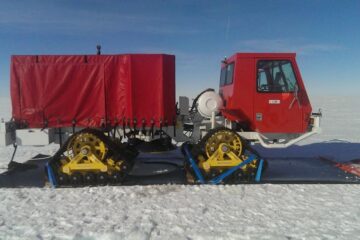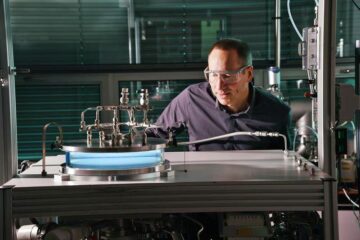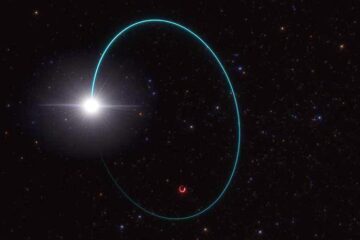A challenging tunnelling project designed with Finnish technology

Freezing used to support a railway tunnel on the Bothnia Line.
The railway tunnel on the Swedish Bothnia Line, on the Western shore of the Gulf of Bothnia, has been the largest artificially frozen structure in the Nordic countries. The tunnel, to be completed this spring, was temporarily strengthened by freezing in accordance with the design by VTT (Technical Research Centre of Finland) . Although a challenging and unconventional construction method, freezing turned out to be the best approach for this particular site from a technical and economical point of view.
Construction planning for the freezing of the Stranneberg tunnel, located five kilometres from Örnsköldsvik towards Umeå, was started in November 2001. Freezing took place in the summer of 2002, and tunnel blasting in the autumn of the same year. The tunnel (100 metres long, 10 metres high and 10 metres wide) required 5000 cubic metres of soft soil and weak rock mass to be frozen. Freezing work on the tunnel line was started in early 2002 with the drilling of freeze pipes, and the tunnel broke through the frozen stretch in December 2002.
Lemminkäinen Construction Ltd, which was renamed Lemcon Ltd in March this year, carried overall responsibility for the tunnelling. The freezing operations benefited from Lemminkäinen’s expertise in tunnel construction and foundation engineering, and from VTT’s expertise in ground freezing design. The final supportive lining of the tunnel will be completed in the spring of 2003, after which the soil will be allowed to melt.
VTT evaluated the progress of freezing, made the stability and displacement analyses, designed the measurements for monitoring tunnel construction, planned the location of the pipelines for freezing, and checked the monitoring results. The design calculations were carried out using advanced software for thermal and geotechnical analysis. VTT also determined the strength and deformation characteristics of frozen soils. The laboratory tests were carried out in the frost laboratory at VTT.
The railway tunnel was constructed at a depth of 20 metres in the soft ground of organic clay at Stranneberg. Open excavation was not accepted for the tunnel construction, because the deposition of excavated soil might have caused environmental problems. Owing to the large dimensions of the tunnel’s cross section, strengthening the soil by freezing was considered to be the technically best and safest approach.
By this project, Lemminkäinen improved its ability to apply ground freezing in demanding ground engineering projects in the future. During the project, Lemminkäinen developed a new, competitive technology product suitable for highly demanding tunnelling and foundation engineering projects.
The Bothnia Line project will be presented at international conferences in the Netherlands and the USA, among others, in 2004. The ground freezing method will be further developed and can be used, for example, in projects carried out abroad and in the Helsinki region in Finland.
Media Contact
Alle Nachrichten aus der Kategorie: Architektur Bauwesen
Die zukunftsorientierte Gestaltung unseres Wohn- und Lebensraumes erhält eine immer größer werdende Bedeutung. Die weltweite Forschung in den Bereichen Architektur und Bauingenieurwesen leistet hierzu einen wichtigen Beitrag.
Der innovations-report bietet Ihnen hierzu interessante Berichte und Artikel, unter anderem zu den Teilbereichen: Nachhaltiges Bauen, innovative Baumaterialien, Bautenschutz, Geotechnik, Gebäudetechnik, Städtebau, Denkmalschutz, Bausoftware und Künstliche Intelligenz im Bauwesen.
Neueste Beiträge

Merkmale des Untergrunds unter dem Thwaites-Gletscher enthüllt
Ein Forschungsteam hat felsige Berge und glattes Terrain unter dem Thwaites-Gletscher in der Westantarktis entdeckt – dem breiteste Gletscher der Erde, der halb so groß wie Deutschland und über 1000…

Wasserabweisende Fasern ohne PFAS
Endlich umweltfreundlich… Regenjacken, Badehosen oder Polsterstoffe: Textilien mit wasserabweisenden Eigenschaften benötigen eine chemische Imprägnierung. Fluor-haltige PFAS-Chemikalien sind zwar wirkungsvoll, schaden aber der Gesundheit und reichern sich in der Umwelt an….

Das massereichste stellare schwarze Loch unserer Galaxie entdeckt
Astronominnen und Astronomen haben das massereichste stellare schwarze Loch identifiziert, das bisher in der Milchstraßengalaxie entdeckt wurde. Entdeckt wurde das schwarze Loch in den Daten der Gaia-Mission der Europäischen Weltraumorganisation,…





















